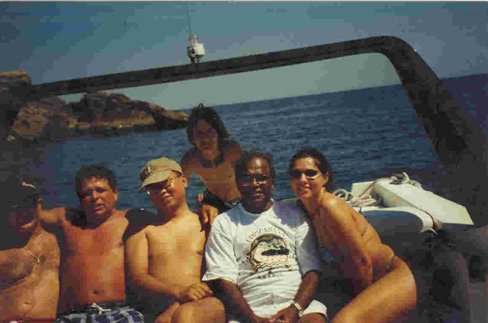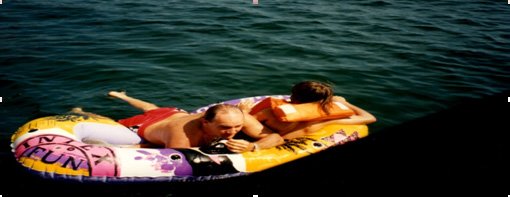America
How Portugal failed to colonize Calicut: Chat with a Brazilian (Travel with MP Prabhakaran)
By
By M.P. Prabhakaran
(This is Chapter 4 from Mr. Prabhakaran’s book, An Indian Goes Around the World – I: Capitalism Comes to Mao’s Mausoleum, which we have been serializing in this space every week. Chapter 5, “Hunchback and Sugar Loaf: Two Tourist Attractions in Rio,†will appear next week. Read every Monday. – Editor)
It was a pleasant evening, and I was taking a stroll on Copacabana Beach. To my left was a row of hotels and expensive mansions and, to my right, the Atlantic Ocean. I couldn’t help envying those sitting on the balconies of their hotel rooms and enjoying the spectacular view in front of them – over what sort of drink I couldn’t tell. “One day, maybe after I win the New York Lotto, I will have a chance to stay in one of those hotels and give myself that luxury,†I said to myself.
It took only a few seconds for me to dispel that envy, with this chastening thought: “Did I ever dream while growing up in that remote village in India that one day, I would be taking an evening stroll on the world-famous Copacabana Beach? I should feel blessed.†I continued my stroll until it was dark and then headed for my hotel.
Little did I know while heading for the hotel that another excitement was waiting for me there. As I entered the hotel lobby, I saw a group of people chatting. One of them came up to me and introduced himself. He was the owner of the hotel. “Which part of India are you from?†he asked.
“What made you so sure that I am from India?†I asked, elated by the question, of course.
“There is no mistaking of it,†he said. “The stamp is there on your face.â€
“I am impressed,†I told him. “I am from Kerala, which is in the southwestern corner of the country.â€
I could sense the direction the conversation was going to take. My status as a resident of New York had little relevance to it. So I decided not to mention it for the time being.
“I know where Kerala is,†he said. “How far is your home town from Calicut?â€
The question took me by surprise. I was not expecting it from a hotel owner in Brazil. He gave me a warm handshake, as if I had delivered him a gift, when I told him that Calicut was only a few miles away from my home town. I also told him that Calicut would always have a special place in my heart. I had my undergraduate education at a famous college there. “By the way,†I added, “the name of the city has officially been changed to Kozhikode, which was its original name.â€
Not wanting to be out of step with other developing countries, cities and states in India have lately been restoring their original names, which had been changed by colonial powers during their rule. They did it because they couldn’t pronounce most Indian place names. In restoring the old names, Indian leaders have often taken their nationalistic (parochial?) zeal to ridiculous levels. Bombay is now called Mumbai, Calcutta has become Kolkata, Madras is now Chennai and so on. The Brazilian thanked me for the update and made a few futile attempts to pronounce Kozhikode correctly.
“Don’t feel bad,†I told him, “Even non-Malayalee Indians have difficulty pronouncing it correctly. A Malayalee, by the way, is one who speaks Malayalam and Malayalam is the language of Kerala. There is no equivalent, in most other languages in the world, to the Malayalam letter represented by ‘zh’ in Kozhikode. We can go into all that some other time. First tell me where your interest in Calicut comes from.â€
Cabral Left for Calicut, but Ended Up in Brazil
It came from his keen interest in history. Being a history enthusiast myself, I couldn’t help taking an instant liking to him. He told me how, by a quirk of circumstance, Calicut got linked to the history of Portugal’s colonization of Brazil. He summed up the link this way: “Do you know that if Cabral had not lost his direction, while on his way to Calicut, Brazil would not have become a Portuguese colony?â€
He was being flippant about an important phase in Portugal’s overseas expansion. But the question, however, gave an interesting turn to our conversation. I told him how Portugal failed to colonize Calicut.
Pedro Alvarez Cabral led the second Portuguese expedition to Calicut. The first one was led by Vasco da Gama who had reached Calicut on May 27, 1498. As a mission whose goal was “to seek Christians and spices,†to quote Vasco da Gama himself, it was a failure. The Arabs, who controlled the entire Indian Ocean trade at the time and who had a monopoly over the spice trade of Calicut, placed all sorts of obstacles on the Portuguese path. With a view to overcoming those obstacles, the Portuguese armed their second expedition formidably and put it under the command of Cabral, an able navigator.
With 13 ships and 1,200 “boldest and most famous seamen of the century†on board, Cabral left Lisbon for Calicut on March 9, 1500. Unfortunately, he did not have a smooth sail. On April 22, he found himself on the coast of Brazil.
There are two versions to how it happened. One goes like this: Anxious to avoid the calm of the west coast of Africa that had considerably slowed the voyage of his predecessor, Cabral went in a decidedly southwestern direction. He realized his mistake only when he spotted a land that did not fit the description of Calicut. The new land he spotted later came to be called Brazil.
The second version is that, before he could veer his fleet around the Cape of Good Hope, a storm drove it off, all the way to the coast of Brazil. More historians have found this version plausible, mainly because of the recurrence of storms in that region. It was one such storm that had driven Bartholomeu Dias’s expedition around the southern tip of Africa, in January 1488. For that reason, Dias decided to call it the Cape of Storms. King John II of Portugal later renamed it the Cape of Good Hope, because of the hope it offered of finding a sea route to the East.
If it was a storm that accidentally took Dias around the tip of Africa and paved the way for the epochal discovery of the sea route from Europe to the East, another storm 12 years later, not far from the same place, drove the Portuguese fleet destined for the East away from its chosen path! It is an irony of fate that one of the ships on Cabral’s fleet that were destroyed by the storm was commanded by the same Bartholomeu Dias.
Be that as it may, the serendipitous discovery of Brazil by the Portuguese, on April 22, 1500, proved to be a boon for their king back home. On behalf of King Manuel, Cabral took possession of the new land by erecting a cross and holding a religious service. The service was conducted by Father Henrique, a Franciscan priest whom Cabral had brought along.
Cabral resumed his voyage on May 3, 1500, and finally reached Calicut on September 13. (According to some historians the date was August 30.)
The hotel owner was familiar with all facts up to when Cabral left Brazil and continued his voyage for Calicut. He wanted to know what happened after that and why Calicut did not become a Portuguese colony. I filled him in on that to the extent I could draw on my memory:
The first thing Cabral did after reaching Calicut was to send ashore a local fisherman, whom Vasco da Gama had captured during his visit, with a message for the king, the Zamorin. (‘Zamorin,’ again, is the anglicized form of the Malayalam word Samoodiri, meaning the lord of the sea.) In the caste-ridden society of the time, sending a fisherman as an envoy to a king was considered an insult. Still, the Zamorin’s representatives were courteous enough to negotiate with the Portuguese. After two and a half months’ negotiations, the Portuguese were given permission to build a factory at Calicut. (A factory in those days just meant a trading post under the supervision of a factor.)
Arab-Portuguese Rivalry
The favorable treatment given to the Portuguese upset the Arabs. Fearing loss of the monopoly trading position they had been enjoying for centuries, they caused all sorts of problems for the Portuguese and made it impossible for them to function. A frustrated Cabral captured an Arab ship that was loading at the port. In retaliation, the Arabs, with the help of some local men, attacked and destroyed the Portuguese factory. Factor Ayres Correa and 53 of his assistants were killed in the attack. Cabral struck back. He destroyed ten large Arab ships and captured 600 sailors from other ships. Though those sailors had nothing to do with the Arab-Portuguese rivalry, Cabral slaughtered them all. After bombarding Calicut with cannon fire for two days, Cabral sailed away. What happened at Calicut had international ramifications. It marked the beginning of a prolonged war the Portuguese waged to gain control of the Indian Ocean trade.
The hotelier-cum-history buff Brazilian was very attentive to my narration. I would have gone on and on, but for the fact that I was getting late and feeling sleepy. Before calling it a night, I told him, “History is full of unanticipated occurrences that permanently altered its course. Your reference to how Brazil accidentally became a Portuguese colony reminds me of what some say about how India became a British colony. According to them, if only the Dutch had not upset the merchants of London by increasing the price of pepper from three shillings to six shillings a pound, there would not have been an East India Company and India would never have become an English colony.â€
“Oh, oh!†he exclaimed. “That’s very interesting. I want to hear more about that part of Indian history. It calls for another session.â€
He thought for a few moments and then said, “This Saturday, I am taking my wife and a couple of friends out boating. There’s a lovely spot out at sea where we go swimming now and then. Why don’t you join us? We’ll have a good time.â€
“I don’t swim,†I told him.
“Doesn’t matter,†he said. “Come and enjoy the boat ride. Enjoy the beauty of the Brazilian coast from the sea.â€
“Nothing I would love more,†I said and gave him a hug.
I went to bed that night feeling ecstatic.
(To be
continued)
(M.P. Prabhakaran can be reached at prabha@eastwestinquirer.com)
3) Brahma and Laxmi reincarnate in Brazil? (Travel with M.P. Prabhakaran)
2) Eva Peron’s tomb is too small for her ego (Travel with M.P. Prabhakaran)
1) My Two Embarrassing Moments in Buenos Aires (Capitalism Comes to Mao’s Mausoleum-1: M. P. Prabhakaran)
http://dlatimes.com/article.php?id=40709
(about the author) An Indian Goes Around the World – I (Capitalism Comes to Mao’s Mausoleum)http://dlatimes.com/article.php?id=40126

 The odd man in the picture is the author. He is enjoying a boat ride, off the coast of Rio de Janeiro, courtesy his Brazilian host. Others in the picture are the host’s wife and family friends. All of them, except the author, are getting ready for a swim in the blue waters of the Atlantic. Because the author doesn’t know how to swim, he has an excuse to keep his T-shirt on.
The odd man in the picture is the author. He is enjoying a boat ride, off the coast of Rio de Janeiro, courtesy his Brazilian host. Others in the picture are the host’s wife and family friends. All of them, except the author, are getting ready for a swim in the blue waters of the Atlantic. Because the author doesn’t know how to swim, he has an excuse to keep his T-shirt on. 
























